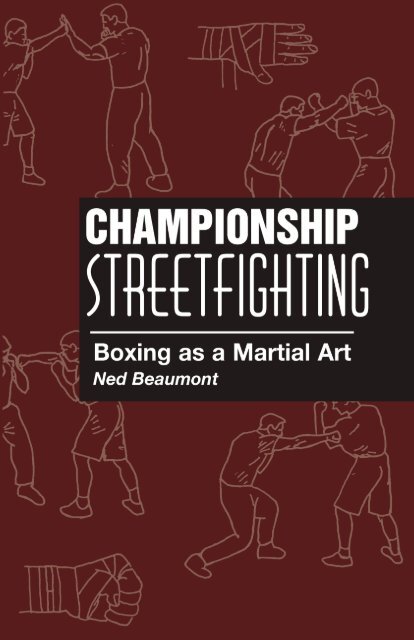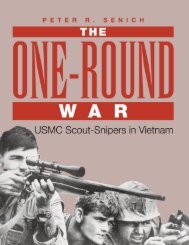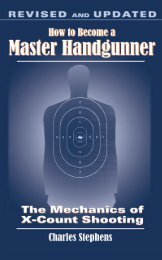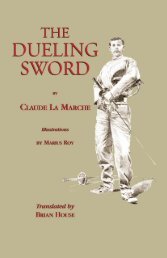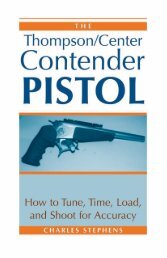Championship Streetfighting: Boxing as a Martial Art
Championship Streetfighting: Boxing as a Martial Art
Championship Streetfighting: Boxing as a Martial Art
You also want an ePaper? Increase the reach of your titles
YUMPU automatically turns print PDFs into web optimized ePapers that Google loves.
CHAMPIONSHIPSTREETFIGHTING<strong>Boxing</strong> <strong>as</strong> a <strong>Martial</strong> <strong>Art</strong>Ned Beaumont
CONTENTSCHAPTER ONE:WHY BOXING? . . . . . . . . . . . . . . . . . . . . . . . . . . . . . . . .1CHAPTER TWO:PRINCIPLES OF THE RINGAND OF THE STREET . . . . . . . . . . . . . . . . . . . . . . . . . .21CHAPTER THREE:GLOVES AND BARE FISTS . . . . . . . . . . . . . . . . . . . . . .31CHAPTER FOUR:THE PHYSICS AND PSYCHOLOGYOF POWER PUNCHING . . . . . . . . . . . . . . . . . . . . . . . . . . . .49CHAPTER FIVE:STANCE AND GUARD . . . . . . . . . . . . . . . . . . . . . . . . . .67CHAPTER SIX:STRAIGHT PUNCHES . . . . . . . . . . . . . . . . . . . . . . . . . .75CHAPTER SEVEN:HOOKS AND UPPERCUTS . . . . . . . . . . . . . . . . . . . . . .89CHAPTER EIGHT:COMBINATIONS AND RELATED MATTERS . . . . . . . .105CHAPTER NINE:DEFENSE: THE ART OF NOT GETTING HIT . . . . . . .121CHAPTER TEN:FOULS AND OTHER DIRTY TRICKS . . . . . . . . . . . . .139CHAPTER ELEVEN:TRAINING: ROADWORK,GYMWORK, AND FLOORWORK . . . . . . . . . . . . . . . . . .161RECOMMENDED READING:FROM THE RING TO THE LIBRARY . . . . . . . . . . . . .185V
CHAPTER ONEWHY BOXING?Think of any bar fight orstreet fight you’ve foughtor even witnessed, becausewe often learn <strong>as</strong> much from the fights we watch <strong>as</strong>from those in which we participate. (Being less immediatelyconcerned with blood and survival allows for the luxury ofdetachment and clearer analysis.)Think only about real fights, ones in which real peopleget really hurt. As someone once told me when I said that I’dbeen in a fight, “Is anyone dead? Is anyone in the hospital? Ifnot, then it w<strong>as</strong>n’t a real fight. It w<strong>as</strong> just fun and games.”That means you must eliminate all the false and potentiallydangerous nonsense you’ve seen in the movies. Forgetall the chop-socky stuff of Chuck Norris, Steven Segal, andJean-Claude Van Damme. Forget about the spinning roundhousekicks to the head, the leaping sidekicks that topple300-pound goons, and all the rest. It may look great on thescreen, but it doesn’t work in real life-or-death, down-anddirtyfights for keeps on the street.While you’re forgetting about the martial arts movies,eliminate all the examples of fistfighting that you may haveseen on-screen. I’m thinking of the barroom brawls in JohnWayne westerns or the fistfight in Shane. You know the type:repeated roundhouse swings to the head and no one breaks1
his hands or suffers damage to the head more serious than atrickle of blood from the corner of his mouth and somemussed-up hair.The movie brawl is meant to entertain. And it doesentertain, especially in Wayne films (nobody beats TheDuke, even today). Movie brawls don’t represent bloodyreality, however.So now you know the kind of fights we’re dealing within this book. We’re dealing with the real thing. And in every realfight, win, lose, or draw, in which I’ve participated orwatched, the issue w<strong>as</strong> decided by a punch, usually a punch tothe head.In other words, in genuine fights in bars, alleys, and otherwiseunsupervised are<strong>as</strong>, the winner fought like a boxer. Heused hard punches to put the loser on the ground. He usedboxing skills in hand-to-hand combat.Nevertheless, nowadays, when the average Americaninterested in developing hand-to-hand combat skills thinks ofa fighting system, he automatically thinks of everythingother than boxing. He may consider Japanese karate,Chinese kung fu, or Korean taekwon do. But he almostalways thinks of some Oriental system of bare-handed combatinstead of good ol’ American boxing.Such w<strong>as</strong>n’t always the c<strong>as</strong>e.BOXING: THE OLD-TIMEMETHOD OF SELF-DEFENSEIt w<strong>as</strong>n’t until World War II, when the United Statesfought the Japanese, that more than a handful of Americansthought about martial arts or Asian methods of hand-to-handfighting. For purposes of propaganda, the average Japaneseinfantryman w<strong>as</strong> portrayed <strong>as</strong> a kind of Superman. His skillat the sly tricks of Oriental fighting made that slight Japanesemore than a match for an all-American boy a head taller andCHAMPIONSHIP STREETFIGHTING2
30 pounds heavier. (Such tales made it e<strong>as</strong>ier to nuke ornapalm the Japanese into submission, rather than fight himat close quarters.) The mythical Japanese used jujutsu orjudo, so those were the styles Americans took to studying.Look at military, police, and civilian self-defense manualsfrom the 1940s and 1950s, and you’ll notice that ninetenthsof them teach a style labeled “combat judo,” “modifiedjujutsu,” or some similar concoction. Whatever the precisename, it always contained the magic word “jujutsu” or“judo.” Such names were even used when the system taughthadn’t the slightest resemblance to genuine Japanese styles.The names were enough to sell to the public. James Bondand Johnny Quest’s bodyguard, Race Bannon, both usedjudo because judo w<strong>as</strong> the hip thing to know.Karate remained something mysterious in the UnitedStates well into the 1960s. Oddjob, of course, used karatein Goldfinger (not to mention that d<strong>as</strong>tardly bolo), but mostof both the bad guys and good guys in the movies stuck tomore mundane methods of fighting. Karate w<strong>as</strong> still a specialtrick: when Muhammad Ali wanted to add an aura tothe punch with which he knocked out Sonny Liston intheir second fight, Ali called it a “karate punch” (really itw<strong>as</strong> just a well-timed straight right). Karate w<strong>as</strong> still somethingexotic, but it w<strong>as</strong> gaining on boxing in the popularpress and our imaginations.The kung-fu craze of the early 1970s sealed the dominanceof Oriental martial arts over boxing in the public’smind. The Kung Fu TV show and all those Bruce Lee moviesspurred on a horde of lesser imitators (think of Billy Jack or,better yet, don’t). Now, any action hero worth his salt ismore likely to launch a spinning round kick than he is tothrow a one-two combination.But in real life, boxing still works, and it works betterthan most Asian martial arts. And it h<strong>as</strong> worked well in theWest for 200 years or more. Until well after World War II,WHY BOXING?3
oxing w<strong>as</strong> what Americans studied when they wanted tolearn about unarmed combat.THE ORIGINS OF BOXING<strong>Boxing</strong> is sometimes referred to <strong>as</strong> “the noble science ofself-defense,” and that’s exactly how modern boxing developed:<strong>as</strong> a practical means of self-defense for the street.From ancient literature and archaeological discoveries,we know that the ancient Greeks and Romans boxed. Wealso know that ancient boxing w<strong>as</strong> crude compared to modernstyles. The Greeks used clubbing and roundhouse blowsand gave little thought to footwork and defense. TheRomans, never a people to shun blood, developed a kind ofspiked glove or hand wrap, the cestus. It made a boxer’spunches more dangerous, often deadly.During the Middle Ages, boxing w<strong>as</strong> rarely practiced <strong>as</strong>a sport. Even the limited skills of the ancient pugilists seemto have been lost. <strong>Boxing</strong> skills wouldn’t have been muchuse for the sort of hand-to-hand combat employed inMedieval times, either; just try to punch it out bare-fistedagainst a warrior covered in chain mail and wielding abroadsword, and you’ll just have your head handed to you(quite literally). Europeans, with access to weapons and technology,eventually learned to defeat knights in armor bydeadlier means than fisticuffs; longbows, crossbows, andfirearms did the trick. It w<strong>as</strong> only the disarmed pe<strong>as</strong>ants ofthe Orient who had to develop bare-handed martial arts tobattle samurai and the like. That’s why those unarmedAsians usually lost their fights and remained pe<strong>as</strong>ants.Those same developments in weapons technology (especiallythe invention of gunpowder and the development offirearms) that brought an end to a thousand years of dominancefor armored horsemen on European battlefields also led indirectlyto the development of modern boxing. When guns madeCHAMPIONSHIP STREETFIGHTING4
heavy armor obsolete, they also made battle-axes, morningstars, and similar heavy, hand-carried weapons less desirable.What w<strong>as</strong> needed were a f<strong>as</strong>t and light sword and an efficientway to fight with it. Thus w<strong>as</strong> born modern fencing; that is,swordfighting b<strong>as</strong>ed not on the hack-and-sl<strong>as</strong>h tactics of a manin armor, but rather on speed, footwork, and, above all, thestraight lunge. From fencers, fistfighters in the West learned tothrow straight punches—the b<strong>as</strong>is of modern boxing.James Figg, an 18th-century Englishman, is usually consideredto have been the first heavyweight boxing championand the father of modern boxing. Figg developed the fundamentalsof effective fistfighting: straight punches that landwith bone-breaking force and the skills of slipping andblocking necessary to defend against those punches.Figg fought not only in the prize ring for sport andmoney, but also in the streets for survival. His techniques offist fighting were <strong>as</strong> applicable in hand-to-hand combat <strong>as</strong>they were between the ropes. It w<strong>as</strong> no accident, then, thatJames Figg w<strong>as</strong> a m<strong>as</strong>ter of many forms of combat. Hetaught fencing, the broadsword, and the quarterstaff in additionto boxing.London in the mid-1700s w<strong>as</strong> a big, booming internationalport, and there were no such things <strong>as</strong> policemen. Itcould be a dangerous place for those who didn’t know howto defend themselves. Figg realized that we don’t always havea weapon on hand, and sometimes we must fight unarmed.Therefore he developed boxing <strong>as</strong> an effective means ofstreetfighting without weapons. Figg made a good living byteaching English gentlemen how to defend themselvesagainst ruffians and riffraff by means of knockout punches.From those beginnings under James Figg, boxing grewmore and more popular, both <strong>as</strong> a sport and a practicalmeans of self-defense. In England and America, it alwaysused to be that when someone “knew how to fight,” thatmeant that he knew how to box.WHY BOXING?5


